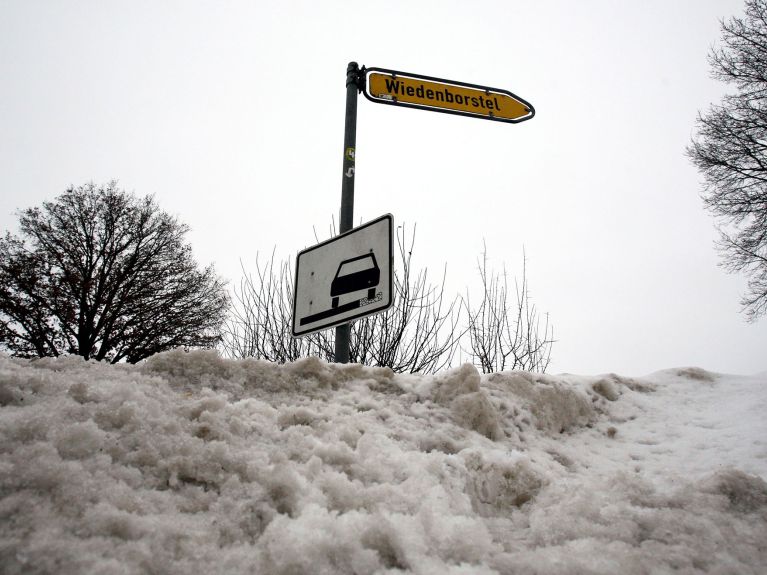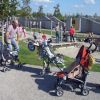Where German people live
A glance at the map of Europe’s most populous country shows that Germany’s 82 million inhabitants live in a multitude of different towns and communities.

About 60 kilometres north of Hamburg, the yellow place-name sign on country road no. 121 indicates the way to what is probably Germany’s topmost rural idyll: Wiedenborstel. And, according to the experts at the Federal Statistical Office, it is the smallest hamlet. With just eleven inhabitants, including the mayor, this mini-village in Schleswig-Holstein heads the list of the smallest communities in Germany. It’s a quiet life for the residents of Wiedenborstel, which nestles in the heart of a nature park. Neighbourhood takes on entirely different dimensions here. In an area of 4.5 square kilometres, the population density of Wiedenborstel amounts to just 1.1 inhabitants per square kilometre. The contrast with the whole country is dramatic: in Germany the average is about 230 inhabitants per square kilometre, making it one of Europe’s most densely populated countries. The extreme opposite to the world of Wiedenborstel lies some 350 kilometres to the southeast: Berlin, with its population of around 3.4 million people. The capital is Germany’s largest city. It is also the country’s most populous metropolis, pulsing with big-city life and boasting 3,849 inhabitants on each square kilometre. Only The Bavarian capital, Munich, is more densely populated with 4,405 inhabitants per square kilometre.
Wiedenborstel and Berlin: two examples illustrating where people live in Germany and how strong the contrasts can be between the periphery and the centre. A glance at the map and the settlement structure of Europe’s most populous country clarifies the picture: on Germany’s 357,021 square kilometres, 82 million inhabitants live in a multitude of different towns and communities. Of the approximately 4,500 municipalities and associations of municipalities, 30% are towns or cities and 70% are rural communities. However, the large percentage of rural communities is deceptive. The bulk of the population lives in an urban environment. About three-quarters of Germany’s inhabitants live in metropolitan regions.
Work, shopping, leisure and cultural activities: the urban researcher and sociologist, Professor Martina Löw from the Technische Universität Darmstadt, sees cities as the crystallization points of social, cultural and professional life, and as places where people like to live. By international comparison, Germany’s urban character is shaped by a system of numerous, different sized cities and metropolitan regions. The remarkable thing is that, although there are many large cities, only four have more than a million inhabitants: Berlin, Hamburg, Munich and Cologne. And there’s another striking point about the German federal system: the capital, Berlin, is not the only major urban centre. The big picture from outer space offers remarkable proof. At night the glowing illuminations of several large areas are visible. Theoretically, an astronaut could pick out 81 large towns, 611 medium-sized towns and 1,584 small towns. In the north, east and south, he or she would be able to identify individual large metropolitan regions and areas characterized by small towns and villages. But the west would look quite different, since most of the population is concentrated in the huge conurbations of the major economic regions on the Rhine, the Ruhr and the Main, as well as in the southwest German agglomeration areas.
The classic rural population that lives permanently on the land is more of an exception in Germany. Nowadays, rural life is often found in the surrounding region or within reach of large cities, where about 40% of all the jobs are located. Many communities in big city catchment areas have developed dynamically, says a study on rural life (Landleben – Landlust?) by the Federal Institute for Research on Building, Urban Affairs and Spatial Development (BBSR). The report concludes that country life is more often associated with family life in privately owned homes, and that mobility usually requires a car. Yet rural areas also differ greatly: villages close to large cities are unlike those in more remote areas, since the social structure of their population is different.
Germany is a society on the move and mobility plays a major role. Whether they marry or find a new job, people often move for personal reasons. In Germany a fairly stable trend is visible in change of residence: people tend to move from the north and the east to the economically strong south and southwest. However, in recent years, the number of people moving within Germany has continually decreased. This century, around the middle of the first decade, about 3.5 million people moved to a different place of residence (4.2% of the population), half a million less than in the mid 1990s. People from the south of the eastern German states are attracted especially to Bavaria and Baden-Württemberg, whilst people from the northeast often go to Hamburg and North Rhine-Westphalia. In addition to this, the generation of 18 to 30 year-olds is highly mobile, whereas older people are more settled.
The Leibniz Institute for Regional Geography in Leipzig has examined some changes more closely in its German National Atlas project. It concludes that the years since the fall of the Wall and German reunification in 1989/90 are characterized by dynamic migration processes within Germany. Here, a striking feature was that the majority of people moved from the east to the west of the country, but there was also a strong movement from west to east. Between 2000 and 2007 a total of 1.5 million people moved from eastern to western Germany. But at the same time about one million people moved from the western to the eastern states. That’s 120,000 to 140,000 people each year, equalling the population of a fairly large west German city. The most popular destinations were Berlin and Saxony, Germany’s most populous eastern state.
Whilst some parts of rural Germany are experiencing a steady population decline, communication networks are increasing between town and country. The metropolitan regions are a good example. They are regarded as engines of societal, economic, social and cultural development, and they play a major role in international competition between different locations. Germany has eleven metropolitan regions, making it the leader in Europe. And according to a BBSR study, four of these areas are among the continent’s most important metropolitan regions: FrankfurtRhineMain, Rhine-Ruhr, Berlin and Munich. Rhine-Ruhr and FrankfurtRhineMain score well as strong economic regions, Berlin as a political centre and Munich as a centre of science.
Is the metropolitan region a model for the future in face of such challenges as demographic change, resource saving urban development and environmentally friendly mobility? Urban researcher Martina Löw believes that in the long run medium-sized cities will be more attractive than very large ones. “The crucial factor is that people are still able to experience cities as complete entities. That’s the key to identifying with them. When viewed on an international scale, what we call a city in Germany is a very attractive size.”
